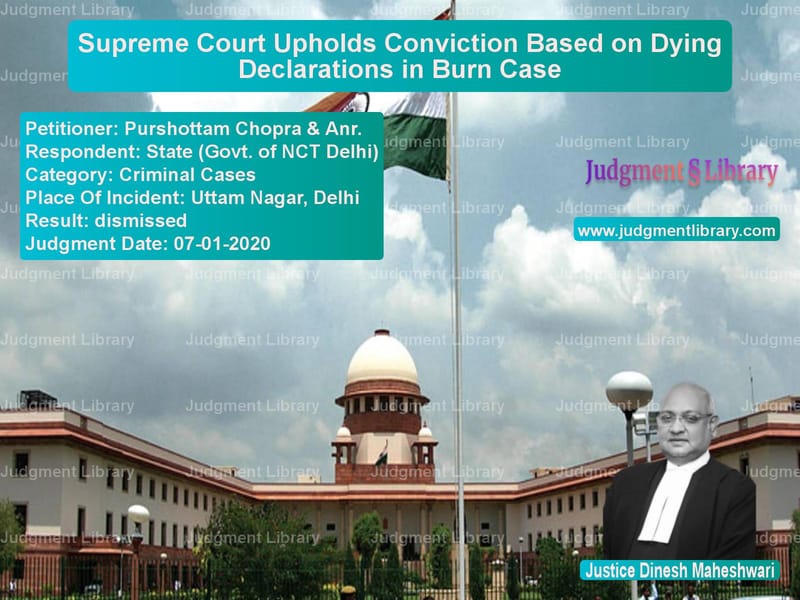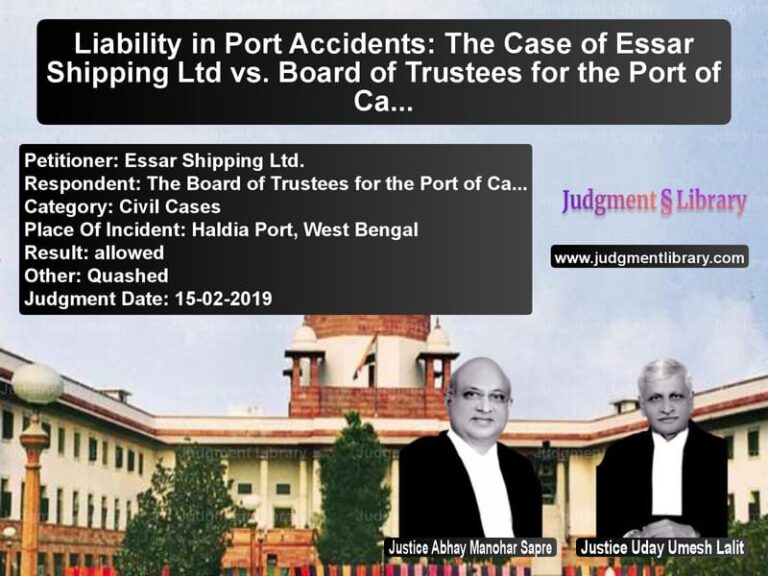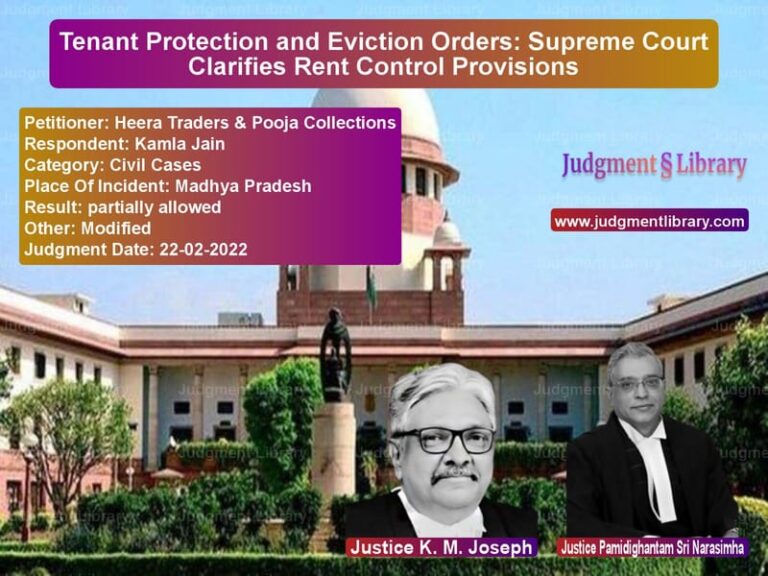Supreme Court Upholds Conviction Based on Dying Declarations in Burn Case
The case of Purshottam Chopra & Anr. vs. State (Govt. of NCT Delhi) is a significant judgment dealing with the admissibility and reliability of dying declarations as evidence. The Supreme Court upheld the conviction of the appellants under Section 302 read with Section 34 of the Indian Penal Code (IPC) for causing the death of one Sher Singh by setting him on fire. The ruling clarifies the legal principles governing dying declarations and their evidentiary value.
Background of the Case
- On December 18, 1997, at around 3:00 PM, screams were heard from plot no. 17, near Goverdhan Park, Uttam Nagar, Delhi.
- People rushed to the scene and found Sher Singh engulfed in flames.
- The police control room (PCR) received a call about the incident at 3:28 PM.
- The police and PCR van arrived, and Sher Singh was shifted to Safdarjung Hospital with 100% burn injuries.
Trial Court Proceedings
The prosecution’s case was primarily based on two dying declarations:
- First dying declaration: Recorded by Dr. Sushma (PW-8) at Safdarjung Hospital at 4:35 PM. Sher Singh identified Purshottam and Suresh as the persons who poured kerosene on him and set him on fire.
- Second dying declaration: Recorded by SI Rajesh Kumar (PW-16) at 7:50 PM, after obtaining certification from Dr. Rajesh Verma (PW-17) that Sher Singh was fit to give a statement. In this statement, Sher Singh reiterated that Suresh poured kerosene on him and set him on fire while Purshottam was present.
Based on these dying declarations and supporting evidence, the Additional Sessions Judge, Delhi, convicted the appellants under Section 302/34 IPC and sentenced them to life imprisonment.
High Court Appeal
- The appellants challenged their conviction before the Delhi High Court, arguing that Sher Singh had set himself on fire.
- The High Court rejected this defense, ruling that the dying declarations were reliable and supported by medical and forensic evidence.
- The High Court affirmed the conviction and life sentence.
Supreme Court Arguments
Appellants’ Contentions
- The dying declarations were unreliable because Sher Singh had 100% burns and was in critical condition.
- There was no corroboration for the dying declarations.
- The thumb impression on the second dying declaration was suspicious since his hands were severely burnt.
- No motive was established for the crime.
- PW-6 Rajesh, a shop owner near the incident site, testified that Sher Singh had said he set himself on fire.
Prosecution’s Response
- The prosecution argued that both dying declarations were consistent and credible.
- Medical evidence showed that Sher Singh was conscious and oriented at the time of his statements.
- His statements contained specific details about the assailants, their addresses, and their involvement.
- The thumb impression on the statement was valid as some parts of the hands were not completely burnt.
- The defense’s claim that Sher Singh set himself on fire was contradicted by forensic evidence showing kerosene was poured on his back.
Supreme Court Judgment
The Supreme Court upheld the conviction, emphasizing the legal principles governing dying declarations:
- A dying declaration can be the sole basis for conviction if it is truthful and voluntary.
- The presence of a magistrate is not mandatory for recording a dying declaration.
- Medical certification of the victim’s fitness to give a statement is preferred but not mandatory.
- Corroboration is not required if the dying declaration is found to be reliable.
The Court rejected the defense’s claims, stating:
“A person with 100% burns can still be mentally conscious and capable of making a statement. The medical evidence shows Sher Singh was oriented and able to speak.”
The Court also dismissed the theory of self-immolation, noting:
“The forensic evidence indicates that kerosene was poured on the victim, particularly on his back, making self-immolation unlikely.”
Finally, the Supreme Court ruled that the appellants were rightly convicted under Section 302/34 IPC and sentenced to life imprisonment.
Petitioner Name: Purshottam Chopra & Anr..Respondent Name: State (Govt. of NCT Delhi).Judgment By: Justice Dinesh Maheshwari.Place Of Incident: Uttam Nagar, Delhi.Judgment Date: 07-01-2020.
Don’t miss out on the full details! Download the complete judgment in PDF format below and gain valuable insights instantly!
Download Judgment: Purshottam Chopra & vs State (Govt. of NCT Supreme Court of India Judgment Dated 07-01-2020.pdf
Direct Downlaod Judgment: Direct downlaod this Judgment
See all petitions in Murder Cases
See all petitions in Bail and Anticipatory Bail
See all petitions in Judgment by Dinesh Maheshwari
See all petitions in dismissed
See all petitions in supreme court of India judgments January 2020
See all petitions in 2020 judgments
See all posts in Criminal Cases Category
See all allowed petitions in Criminal Cases Category
See all Dismissed petitions in Criminal Cases Category
See all partially allowed petitions in Criminal Cases Category







